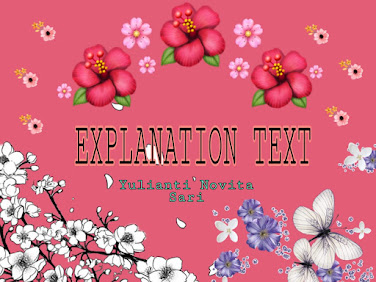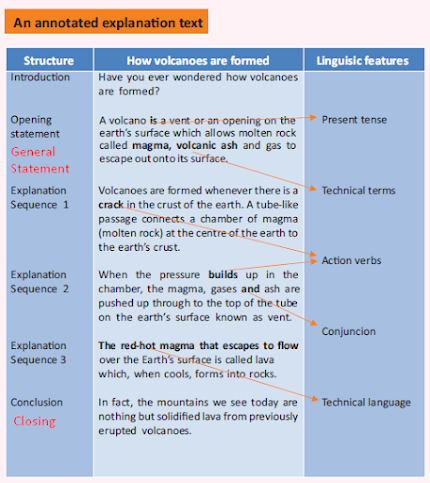🌺Explanation Text🌺
hellow everyone, back again on my blog. this time I will discuss the explanation text. let's read and see the explanation from me. Happy reading.
Definition of Explanation Text
In this section we will
discuss the meaning of Explanation Text. What is meant by Explanation
Text ? What is meant by Explanation Text is a text that is used
to explain the way (process) something happens, especially those related to
natural phenomena, the scientific world or socio-culture. The goal is to
tell the reader or listener how something happened. An explanation text
usually comes from the author's question regarding 'why' and 'how' regarding an
existing phenomenon.
Purpose of Explanation Text
The purpose of the
Explanation Text is to explain the processes that occur in the formation of
something or activity related to natural, social, scientific, cultural, and
other phenomena that aim to explain why and how it happened.
Explanation
Text Characteristics
Explanation text has the
following characteristics:
- Using the Simple Present Tense
The use of simple present
tense is because the explanation text contains the facts of an incident or
action.
- Using Passive Voice
In the explanation text
there must be a sentence passive voice. Why? because this text aims to explain
an event or action (object) rather than its subject.
- Using Chronological Connectors
Almost all texts use chronological connectors. Examples of chronological connectors: First, Second, After that. Next, Then, Finally, etc.
- Using Nouns, Pronouns, and Action Verbs
Explanation text is the
same as any other text which consists of various nouns, pronouns (subject
pronoun, object pronoun, possessive pronoun), action verbs.
Types of Explanation Text
The following are types of explanation text:
- Sequential Explanation
- Factorial Explanation
- Theoretical Explanations
- Causal Explanation
Causal Explanation is the
nature of explanation that progressively explains the origin or cause of
changes in a problem. For example, the landslide process.
Generic Structure Explanation Text
- A general statement
- A sequenced of explanation
It is an explanation of why and how it happened. In this
section the writer can write more than one paragraph. A sequenced of
explanation contains an explanation of the process why this phenomenon can
occur or be created. A squenced of explanation in the form of answers to
the author's 'why' and 'how' questions when making an Explanation text. In
squenced of explanation it may consist of more than one paragraph.
- Closing
Linguistic Rules of
Explanation Text
Explanation text
explains scientifically the process and causes of a phenomenon by using
standard universal languages. The explanation of information in the
explanatory text is easy for general readers to understand or is not limited to
certain circles. Therefore, the writing and use of words in the
explanatory text must be in accordance with PUEBI. The following are the
characteristics of the explanatory text language rules.
- Copula
This word is used to
explain the definition of words, terms, or concepts related to a
phenomenon. For example, in the sentence Indonesia is an archipelago
country.
- Active verb
This word is often used
as part of a series of explanations, because it aims to explain causes and
processes, so that the subject (phenomenon) acts as the goal of a particular
action or event.
- Conjunction
The conjunctions used
explain the causal relationship and the chronological relationship in the
occurrence of a phenomenon. For example, if, if, so, before, first, and
then.
- Adverb of time
This word is used to
describe the time when a phenomenon occurs.
- Scientific term
Context-appropriate
scientific terms are often used to clarify the definition, cause and effect
relationship, or the chronology of a phenomenon.
- Noun pronouns
The subject described
uses a noun (nonperson), such as that, this, and that. The explanatory
text also only focuses on general things, such as earthquakes, floods.
Changes
of pronouns from active voice to passive voice
- Identify the subject, the verb and the object : SVO
- Change the object into subject.
- Put the suitable helping verb or auxiliary verb. In case the helping verb is given, use the same verb but note that the helping verb is given, use the same verb but note that helping verb given agrees with the object.
- Change the verb into the past participle form
- Add the preposition “By”
- Change the subject into object.
Example
|
Active
Voice
|
Passive
Voice |
|
The teacher is going to explain the
lesson.
|
The lesson is going to be explained by
the teacher |
|
She closed the door
|
The door was closed by her |
Example of Explanation Text and Generic
Structure
Example 1 :
How a Tsunami Happens?
A General Statement
We all know that tsunamis are a series of
destructive waves and powerful. Tsunami is the deadliest wave because the
wave speed is incredibly fast. But do you know how a tsunami can happens?
A Sequenced of Explanation
Tsunami originated from Japan,
"tsu" meaning harbor and "nami" meaning wave. They are
normally caused by landslides, earthquakes, volcanic eruptions in, or close to
an ocean. After some sort of underwater disturbance, this causes energy to
rise up to sea level pushing the water high into the air. Gravity kicks in
and pulls it down again and then consequently causing the water to filter out
into many different directions.
When a tsunami begins to approach the
shore the energy in the wave is compressed. As a result, the water is
pushed up into the wave, resulting in a powerful tsunami. If the trough
hits the shoreline first, it then causes the tide to drastically retreat.
Closing
So, tsunamis happen because of natural
disasters such as earthquakes or volcanic eruptions. People who live near
the shoreline have to be careful because they are threatened by tsunamis
whenever there is an earthquake.
Linguistic
rules example Explanatory text how a tsunami happens?
The linguistic rules
consist of:
1. There is a copula,
which is the word used to describe the word. In this text an example of a
Tsunami is a series of powerful and destructive waves.
2. Using active verbs
3. There are
conjunctions, for example in the text, namely if, so, as a result, etc.
4. There is a scientific
term, for example in the text that is it explains the meaning of Tsunami.
5. This text focuses on a
general issue, namely the Tsunami.
6. Using the
chronological connector, for example in the text there is the word first.
7. Using simple present
tense and passive voice
To be clearer, please see the video
below
Example video about explanation text
The video explains How Rainbow Is Happen? the explanation text of the
video, namely:
How Rainbow Is Happen?
A General Statement :
Rainbow often appears after the rain stops. Rainbow consists of a big bow spectrum and happens from water droplets which reflacted paralel because of the light of the sun. When the sun is shining and the light passing through water droplets, we can see a reflaction because of a wide variety of colors. The light passes and reflact like a light passing through a prism mirror.
A Sequenced of Explanation :
Rainbow happen to begin when the sunlight passing through the raindrops. The light is deflected to the center of the droplets. The white light is separated from each other into a spectrum of colors. The colors that have been separated, then separate again into very small portions. There is more light separated from each other in the droplets. Finally those colors form a light curve called rainbow.
Closing :
On the ground, we only see a maximum of a half circle
rainbow. Because rainbow created involving distance with water droplets, the
rainbow always move to follow the movement of anyone who seen it. It makes our
distance with rainbow constant, in other word we could never approach the
rainbow.
This is my video about explanation text
That’s all the explanation from my blog. Hopefully it
can be understood and get benefits for readers. That’s all and thank you. 😊😊💚💚💓💓














Tidak ada komentar:
Posting Komentar